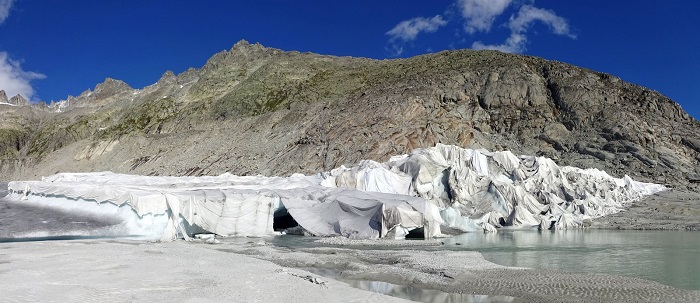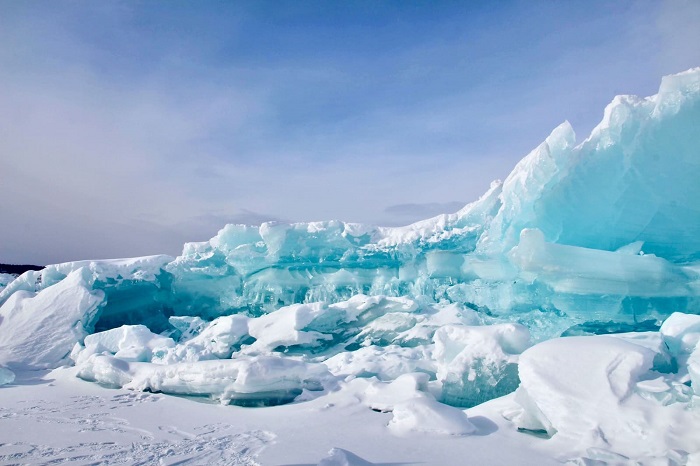ISABEL RUBIO ARROYO | Tungsteno
Saving glaciers from melting is one of the great challenges of this century. Global warming has altered some systems that have lasted for millennia and accelerated the melting of these enormous masses of snow and ice. To combat this, some researchers propose covering glaciers in summer with reflective blankets known as geotextiles. But this system, which increases a glacier's ability to reflect sunlight, is not perfect. We look at its potential and its limitations.
Glaciers melting at an alarming rate
Glaciers are large masses of snow and ice that have accumulated over many years. They are particularly sensitive to changes in climate and are therefore highly visible indicators of climate change. Glaciers around the world have been losing mass since at least the 1970s, according to the US Environmental Protection Agency.
As the temperature of the air and the bodies of ocean water in contact with the ice caps rise, the glaciers melt, causing sea levels to rise. The glaciers in the World Glacier Monitoring Service's climate reference network have lost a volume of ice equivalent to about 25 metres of liquid water since that year, which is about the same as slicing an average of 27.5 metres off the top of each glacier.
Climate change is influencing the melting of glaciers, which has led to a rise in sea levels. Credit: NASA Video
Glacier-covering tarpaulins to slow ice melt
A number of researchers are looking for ways to prevent, or at least slow, this melting. Some ski resorts and tourist attractions use reflective tarpaulins, known as geotextiles, to protect glaciers from melting during the summer. This is the case, for example, in the Swiss Alps and on the Presena glacier in northern Italy, where more than 300 geotextile sheets (70 metres by five metres) are used in summer to cover 110,000 cubic metres of ice. Some studies indicate that white geotextiles can increase a glacier's ability to reflect sunlight by more than 50%.
Deploying 110,000 square metres of reflective tarpaulins on a windswept glacier, 3,000 metres above sea level, requires a major logistical operation each summer. "It should take a team of 11 people, with two snowcats, working for a month and a half," Alessandro Daldoss, vice-president of the Carosello-Tonale company, which manages the slopes and lifts at Passo Tonale, told Wired magazine. But it depends on the weather. On one occasion it took three months "because every three days, rain came, and when there's a storm, you can't work."

Some ski resorts use reflective geotextiles to protect glaciers from melting during the summer. Credit: Matthias Huss.
A solution that is difficult to scale
While it may seem like a promising solution for glacier preservation, the technique has some limitations. Research published in the scientific journal Cold Regions Science and Technology suggests that this strategy is too costly to protect the world’s more than 250,000 square kilometres of glaciers. The authors conclude that artificial mitigation of ice melt is locally efficient but not scalable. "Whilst local interventions can be efficient and profitable, a hypothetical application to the larger scale shows that saving Alpine glaciers by technological solutions is neither achievable nor affordable," they note.
"You can put a blanket in one place on a glacier, let’s say a few hundred square meters, and you can very efficiently protect ice locally. This absolutely works, but it costs a lot of money," Matthias Huss, a glaciologist at the University of Zurich and one of the authors of the study, told GlacierHub. If you have income from the glacier, it can work, he says. But "saving an entire glacier is a completely different story. You would need to cover all of the ice on a much larger scale without a clear income benefit."
These geotextile blankets are designed to increase a glacier's ability to reflect sunlight. Credit: NBC News
"One of the big humanitarian time bombs of climate change"
Making this or some other solution viable is important to slowing the melt. This is especially true given that in many parts of the world—such as the western United States, South America, China and India—glaciers are frozen reservoirs that provide a reliable water supply each summer to hundreds of millions of people and the natural ecosystems on which they depend, according to the US National Oceanic and Atmospheric Administration.
Their accelerating melting, which poses major challenges, is one of the reasons why global average sea levels have risen by more than 20 centimetres since 1880. A study published in the scientific journal Nature Communications in February 2023 concludes that around 15 million people globally are at risk from glacial lake outburst floods. More than half of the exposed population lives in just four countries: India, Pakistan, Peru and China.
Glaciers also accumulate ice in winter and then release water at a steady rate in spring, helping to regulate the flow of streams, rivers and lakes in the valleys and plains below. As Jemma Wadham, Professor of Glaciology at the University of Bristol, points out in her book Ice Rivers, the disappearance of glaciers is "one of the big humanitarian time bombs of climate change."
· — —
Tungsteno is a journalism laboratory to scan the essence of innovation.
